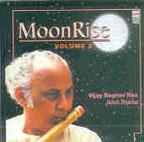Contribute
| Music Review - Moonrise |
Sanjay Kumar
07/27/2006
(This article is sponsored by Sounds Of India)
MOONRISE - Vol. 1 and 2 PT. VIJAY RAGHAV RAO, FLUTE MOONRISE (Vol. 1 & Vol. 2) reveals to us why Indian classical music so enthralled wealthy, endowed Mogul emperors of fine taste and erudition hundreds of years ago as much as it delights a transplanted Indian immigrant as I toil through my paces making a living in a new land. In this album, Pt. Vijay Raghav Rao’s flute is unsparing in its attention to the strict parameters of Raga and Tala that so enamor cognoscenti. But the impeccable classicism of expression is just the palette for a riot of imaginative improvisations spanning three Ragas and a Ragamalika of five other Ragas. The performances unleash fountains of melodic passages; often strung with measured, uncanny precision over the lilting, majestic Tabla of the inimitable Ustad Allah Rakha. Hardly has there been an album of Hindustani music where the Tabla attains heights of such joyous, unbridled expression, even as it contributes effortlessly to the natural synergy gushing forth in its union with the primary solo instrument. If ever there were an album to introduce - without words - the uninitiated to the invisible rigor and obvious delights of Indian classical music, MOONRISE would be it. The album begins with an expansive elaboration of the Raga Hamsadhwani. Students of Carnatic music will be as enthralled as those of Hindustani music listening to this exposition by an artist who - not surprisingly - was born and brought up in South India. Note by note, through unique ideas of line, shape and meter, Panditji lays the foundation of a sparkling edifice. We recognize the scale, but marvel at the freshness of expression. We know the next note, but are wonderstruck by how it is reached. The glorious alap is a joy to listen to repeatedly. If one closes one’s eyes, one can imagine the lovely Taj Mahal basking in the moon’s feathery light. Then follow two exquisite compositions tethered precisely to rhythmic cycles of seven and sixteen beats. If ever one pondered on the confluence of math and music, one need look no further than these gems of Raga and Tala to bask in the resultant beauty. The space between the ends of a cycle are filled with imaginative, self sustaining passages reflecting the Raga’s spirit, yet showcasing artistic excellence. Intelligent fractionations of a simple rhythmic cycle abound : we see and hear musical impressions that instill awe. The second selection in this ethereal canvass of an album is a performance of two compositions in the Raga Malkauns. Is there any human of Indian origin who hasn’t ever felt the charm of this Raga in some way, shape or form ? Not just through the classical idiom of the North or the South, but through popular music, film songs, in jingles, the notes of this perennial Raga courses the soul of our collective Diaspora. And yet in its exposition on MOONRISE, Pt. Vijay Raghav Rao presents a delightful reincarnation of Raga Malkauns that is in ample measure romantic and majestic, stately and hum-able, traditional and modern. A free flowing alap and jor/jhala is followed by tightly woven tapestries in rhythmic cycles of ten and twelve beats. The fast tempo section is rife with consummate give and take between the Flute and the Tabla, leaving us gasping for more. The third selection in this album features Hori Khamaj, a Raga performed during Holi, the festival of colors. Need one reiterate that during this festival, Indians of all kinds celebrate the arrival of spring by anointing each other with colors - blue and red and green and yellow, signifying a coloration of the spirit. Hori Khamaj is known to have been performed first during the Mogul dynasty when classical music was steeped in romantic connotations. As such, Panditji plays this Raga in a lilting, sensuous mode, akin to portraying the movements of a dancer trading spirited banter with others of his ilk. The composition is presented set to a rhythmic cycle of fourteen beats. The music sways and rolls, transporting its listener to a world where color and sound are one. MOONRISE concludes with a unique expression of unity in diversity - the Raga Mishra Piloo Ragamalika. Utilizing all notes of the chromatic scale, Panditji creates a garland of five disparate Ragas. The garland of Ragas, or Ragamalika, is meant to represent the underlying commonality in the human expressions of love, joy, sorrow, despair and compassion. Set to a rhythmic cycle of eight beats, the composition features the essence of the Ragas Shivranjani, Abhogi, Bhopali, Kirwani and Jog unified under a framework provided by the Raga Piloo. The immense craftsmanship of Panditji pours through the performance as the notes of one Raga seamlessly melt into the seemingly disparate notes of another. Each part of this Ragamalika evokes a new emotion, then gives way to another. As one partakes of this dessert, one yearns for more. May the future bring more albums of exceptional music from the genius of Pt. Vijay Raghav Rao!
ACCOMPANIED BY USTAD ALLAH RAKHA KHAN ON TABLA
24 BIT DIGITAL DDD
Ever so rarely, an album of Indian classical music comes along that is as much a revelation as a source of perpetual joy.
The reviewer bought the albums from http://www.shrimatis.com / 510 548 6220, and http://www.indiaclub.com / 856 424 9310, where the albums are among the top of the Music CD ‘Hotseller’ list since March of 2004.
You may also access this article through our web-site http://www.lokvani.com/

